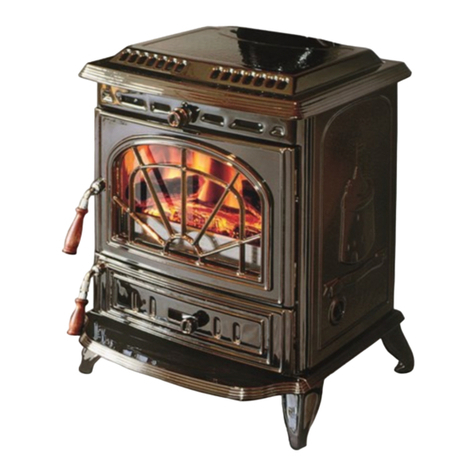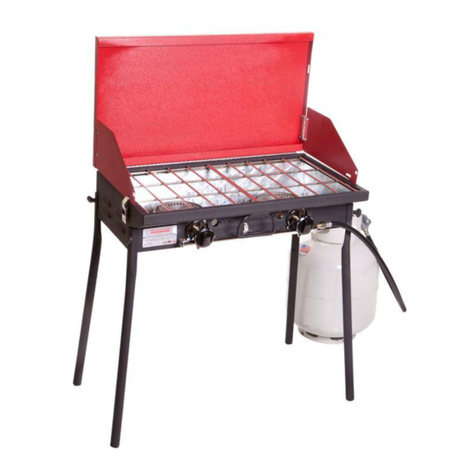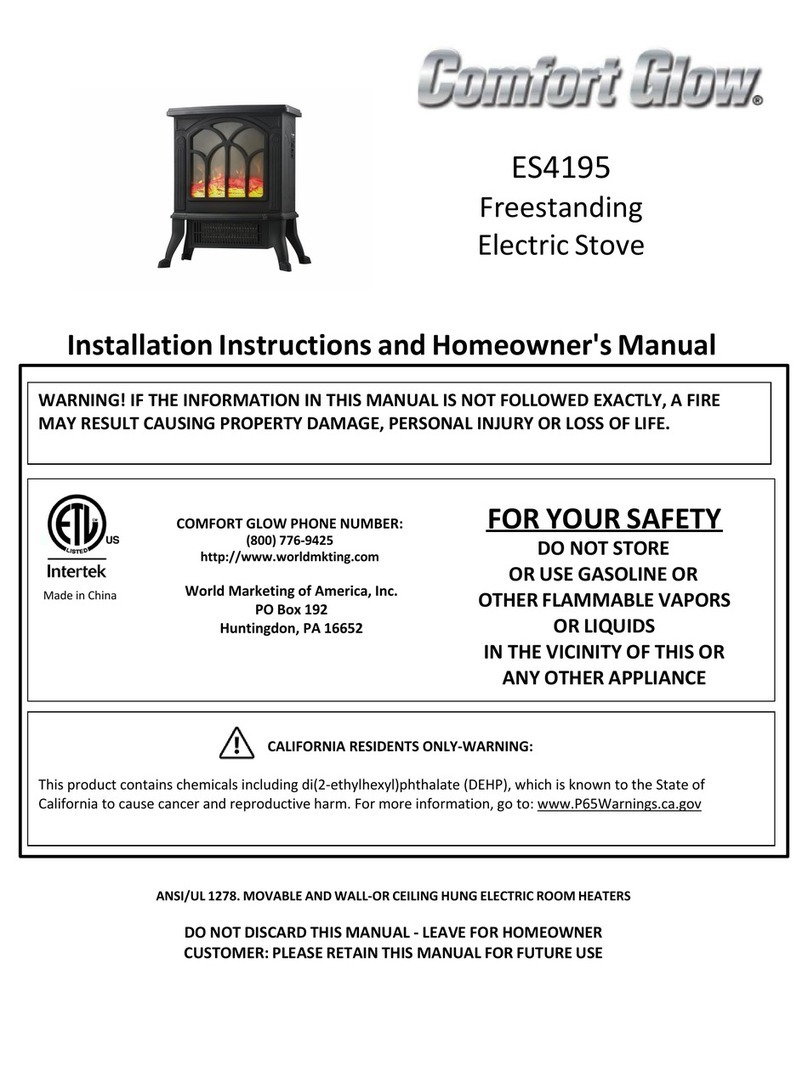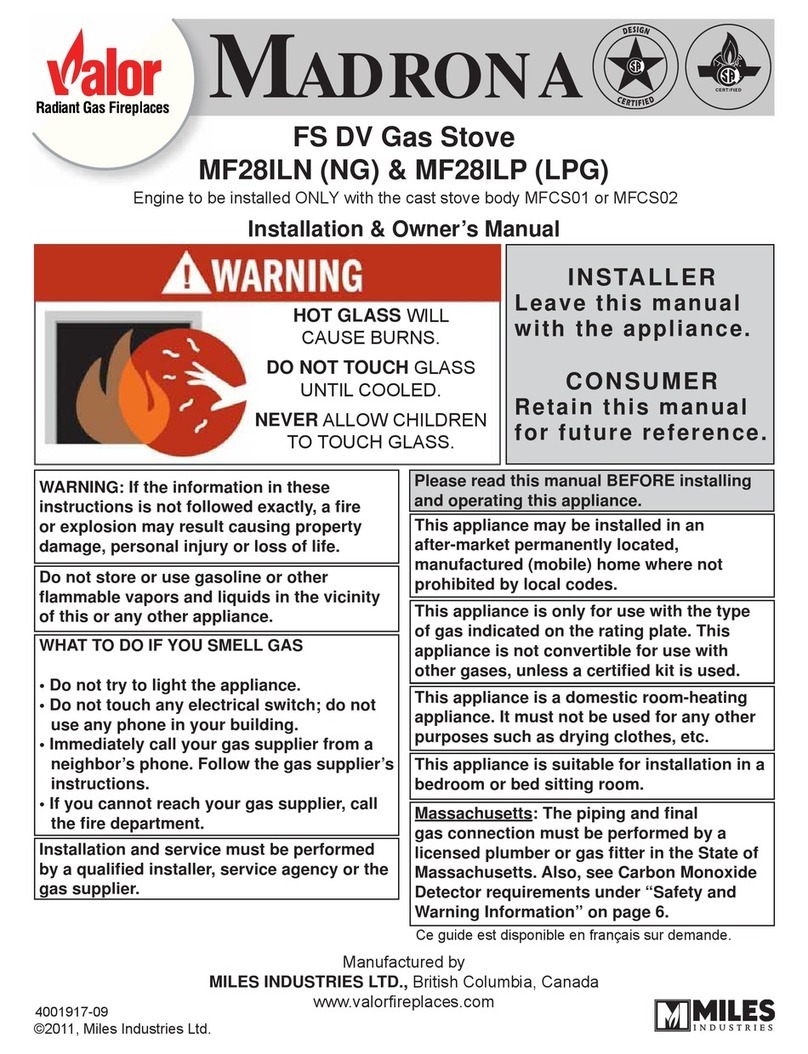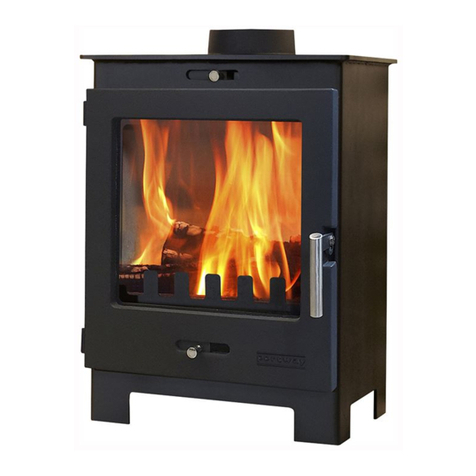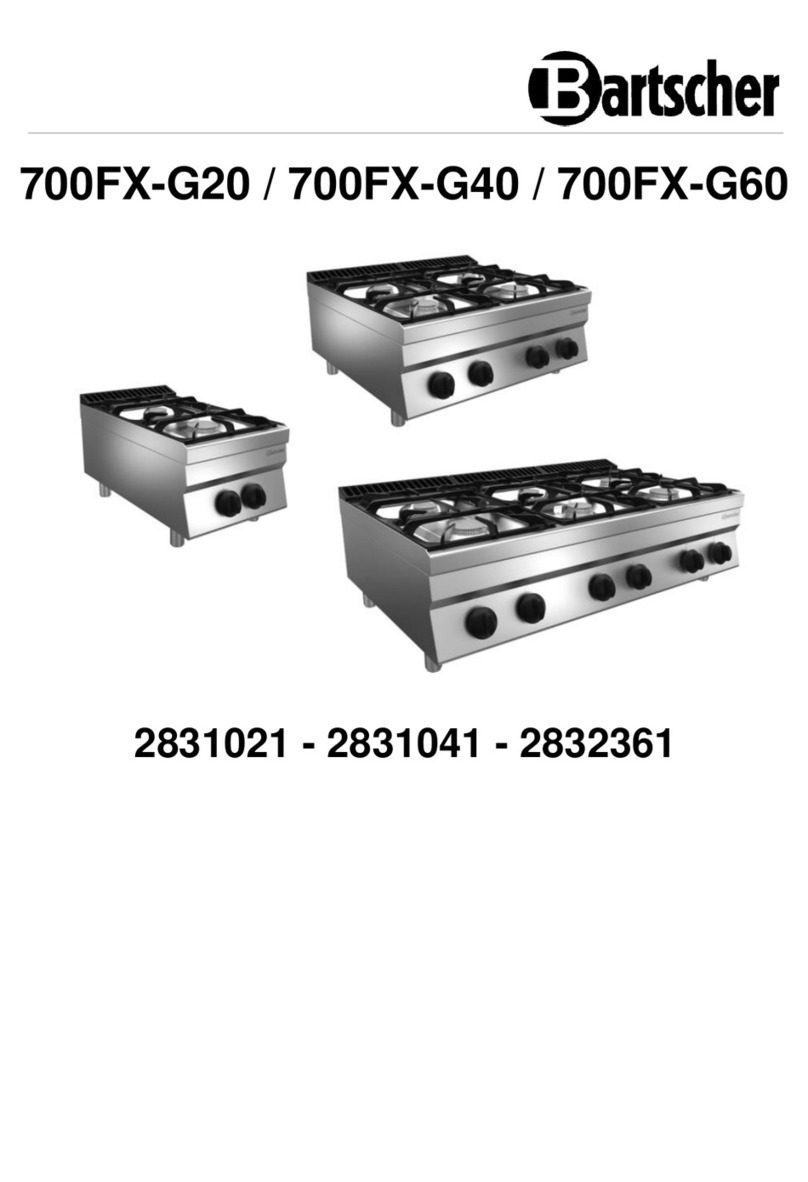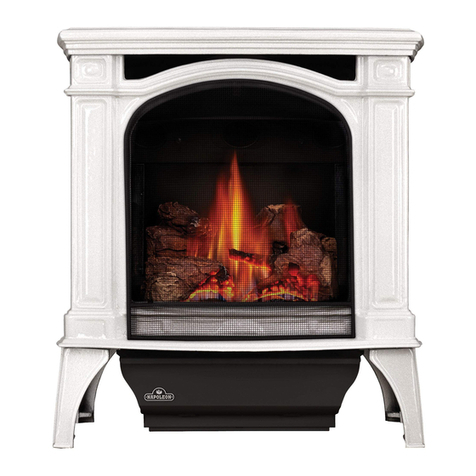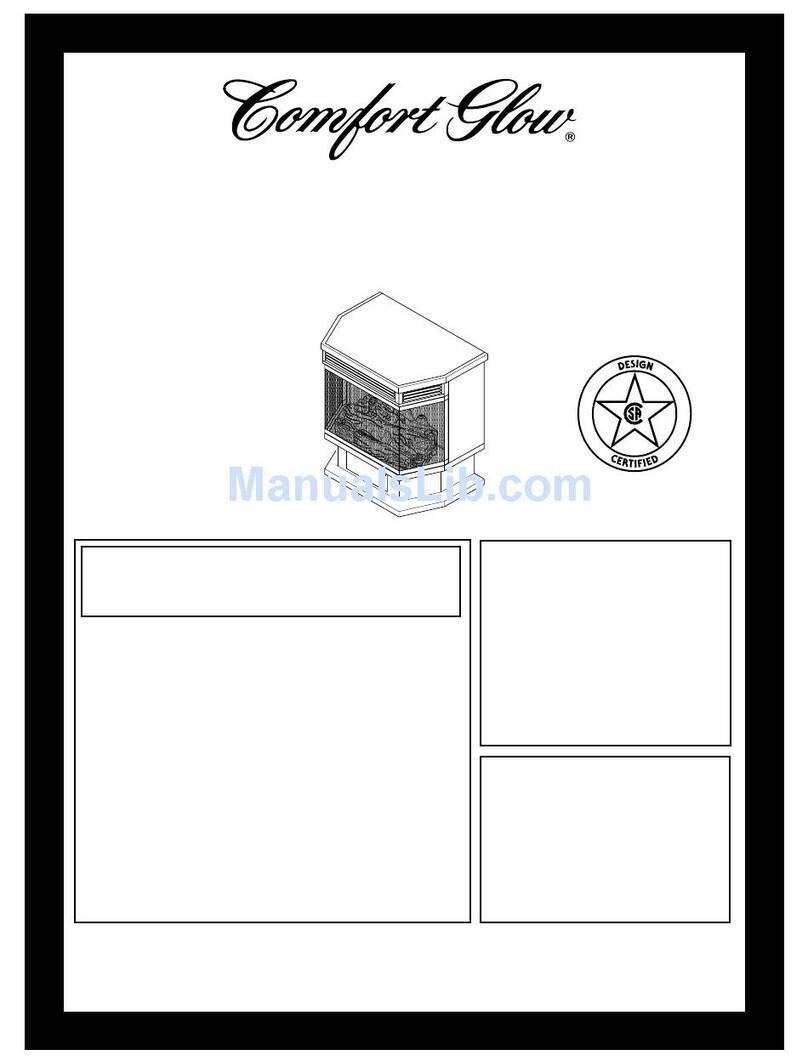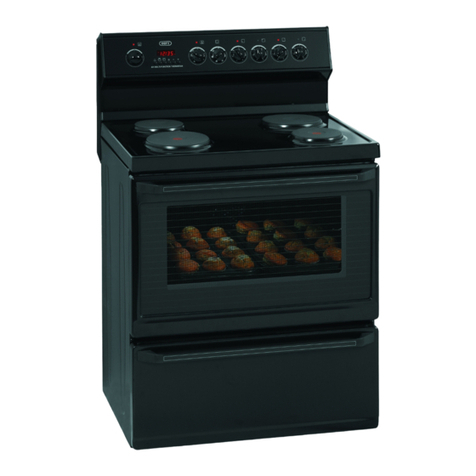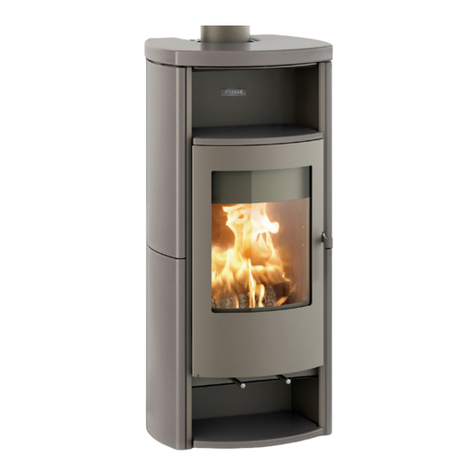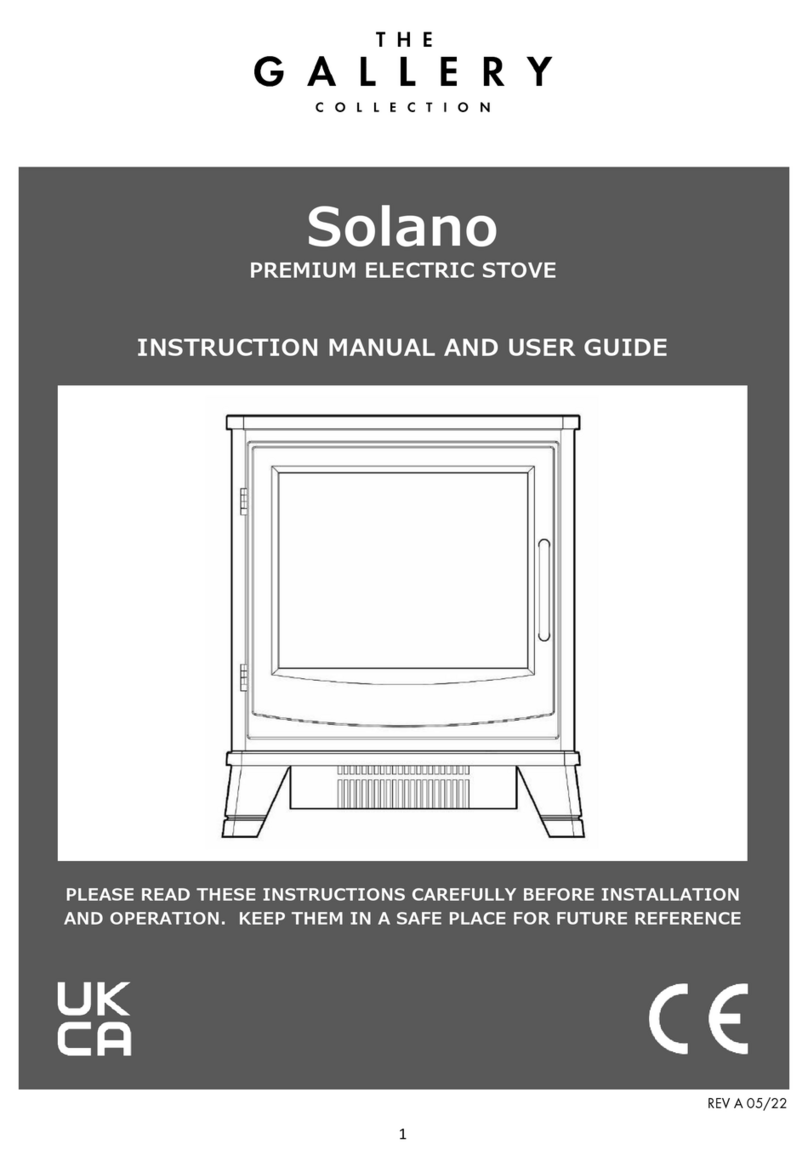Place two or three firelighters close together, or screwed-up
paper covered with dry sticks, at the back of the grate and light
them When they are burning well gently fill the fire with dry fuel,
close the door and set the air control slide to the 'high' (right)
position When the fire is burning well, move the control to the
lowest practical setting
FILLING: Don't fill above the level shown in the diagram
CON ROL How fast the fire burns depends on how much air
reaches the fuel The stove has just one air control, below the
window Move the slide to the right for highest output, to the left
for 'low' The control can get very
hot, so move it only with the handle
supplied
The best settings for you will
depend on your fuel, air supply and
flue draught and can only be found
from experience
EMP YING ASHES Stir the fire
with a poker Use the angled
ashpan tool to lift out the ashpan
Remember to let ash cool before
disposing in plastic sacks or
dustbins There is no need to
empty every last speck, but ash
from mineral fuels should never be
allowed to build up so that it comes
into contact with the underside of
the grate
EX ENDED BURNING Allow the fire to burn down to a low, hot
firebed Empty the ash and fully fill with hard fuel such as
anthracite (c30mm size is best) Set the air control to 'low' and
your stove can burn for up to ten hours without attention
KEEPING HE WINDOW CLEAN Simply operating the stove for
a few minutes at high output will often burn-off any deposits left
by tarry or wet fuels Severe stains can be removed when cold
with a domestic bleach cleaner The window is not glass but a
transparent ceramic, it may develop tiny hairline cracks, these are
harmless, and a characteristic of the toughest and most heat-
resistant material known Reduce the risk of staining by using
only very dry fuel
OPENING HE DOOR This stove is designed to be operated
only with the door closed Open the door very slowly to minimise
fume emission and prevent hot fuel falling out Remember that
the whole stove becomes extremely hot
SUMMER SHU DOWN: Before a long period of non-use, empty
fuel and ash, remove the throat plate and leave all the air controls
open to allow ventilation to reduce condensation
FUELS
There is no 'perfect' fuel, so we strongly recommend that you try
a selection of fuels (or mixtures) to find which suits you best Do
avoid dusty materials like sawdust, they can burn far to violently
SMOKE CON ROL: In certain areas special rules apply to
reduce smoke nuisance Check with your local authority
WOOD only emits as much carbon to the atmosphere as the tree
took in when growing, so wood is considered the 'carbon neutral'
fuel When wood is cut down its cells are full of water Burning
such wet or 'green' wood wastes heat in making steam and
produces flammable, acidic tars which will cling to, and rapidly
damage, your stove and chimney Split logs will typically take two
years to become reasonably dry, round logs very much longer
Cracks in the ends, a hollow sound when tapped and bark falling
away are all signs that a log may be ready for use The fine, white
residue produced when wood burns is not ash, but the remains of
cell walls which can burn if kept hot enough, so don't de-ash the
fire until absolutely necessary when using wood
For best performance, and always for low smoke emission:
Split logs lengthways for drying
• Use logs no bigger than about 100mm x 200mm
• Ensure logs are absolutely dry (less than 20% moisture)
• Fill the stove criss-cross, so air can circulate between logs
• Fill 'little and often'
• When first lighting, or reviving a fire from embers, use only very
small, thin, dry, sticks
JOINERY WAS E Dry wood offcuts will burn well, but don't
expect softwood waste to burn as cleanly or for as long as
hardwood logs
PEA : Sod turf must be thoroughly dry BNM peat briquettes are
approved for use in Smokeless Zones in the RoI
LIGNI E (not smokeless) is a natural mineral, between peat and
coal It lights easily and burns well, but produces much ash
HOUSECOAL or BI UMINOUS COAL (not smokeless) makes
lots of tarry smoke and large volumes of flammable gas which
make it difficult to control and risk explosions Despite its low
cost, it rarely represents value for money Don't use housecoal
AN HRACI E (Smokeless) is a natural hard, shiny form of coal
Slow to light, it can burn for very long periods with great heat
Despite its high price-per-bag it generally works out to be one of
the cheapest of all fuels Use the 'small nuts' size
COKE (Smokeless) is coal from which the smoke has been
removed Sometimes difficult to light, it burns very cleanly
BRIQUE ES Are compressed blocks of fuel, generally able to
burn for long periods and remarkable for their consistency
'Homefire' and 'Phurnacite' are smokeless types while other
brands are made from lignite, peat or housecoal
PE ROLEUM COKE sold as 'Petcoke', 'Longbeach' and other
names, is made from oil, should not be used, it will rapidly
degrade interior parts
HOUSEHOLD WAS ES Some plastics give off toxic fumes when
burned and remember that batteries and aerosols explode! The
stove is not an incinerator, so only ever use the recommended
fuels and NEVER use liquid fuels in any form
PROBLEMS?
Problems like those listed here are usually due to some difficulty
with the installation, chimney or fuels, so please check back
through this leaflet carefully If necessary seek specialist advice
SMOKE FROM HE CHIMNEY It is quite normal for a little
smoke to be emitted from the chimney when the fire is cold Use
only VERY dry wood or smokeless fuels
DAMAGED LINERS The Cub stove gets very, very hot inside, it
is quite usual for the replaceable liners to crack or craze They
need only be replaced when they have almost completely
disintegrated Help them last longer by using only very dry fuel
POOR HEA OU PU : A stove can heat a typical room of about
12m³ volume for each kW of output, so a 5kW model can heat up
to (12 x 5) 63m³, a room of about 5m square The actual size
depends on the insulation and air-change ratio of the room To
attempt to heat a larger room will result in excessive fuel
consumption and damaging overheating
LACK OF CON ROLLABILI Y Wood and some other fuels may
burn excessively until the gases in them have been used up You
can reduce this effect by making sure that the fire is set to 'low'
for a while before refuelling and checking that the door seals fully
DIFFICUL Y BURNING FOR EX ENDED PERIODS If the fire
goes out with fuel still in the firebox, then this is probably because
too little air has been reaching it, try leaving the air controls open
a little more Check that the door seals are sound and that there
are no cracks or gaps anywhere in the flue For longest burning,
we recommend hard fuels such as anthracite
HE DOOR CA CH may need
adjusting as the rope seal 'beds
down' Simply loosen the screw at
the end of the shaft and move the
tapered pin as required Re-tighten
the screw
CONDENSA ION onto cool
surfaces inside the stove can be
severe if fuel is in any way damp
3





